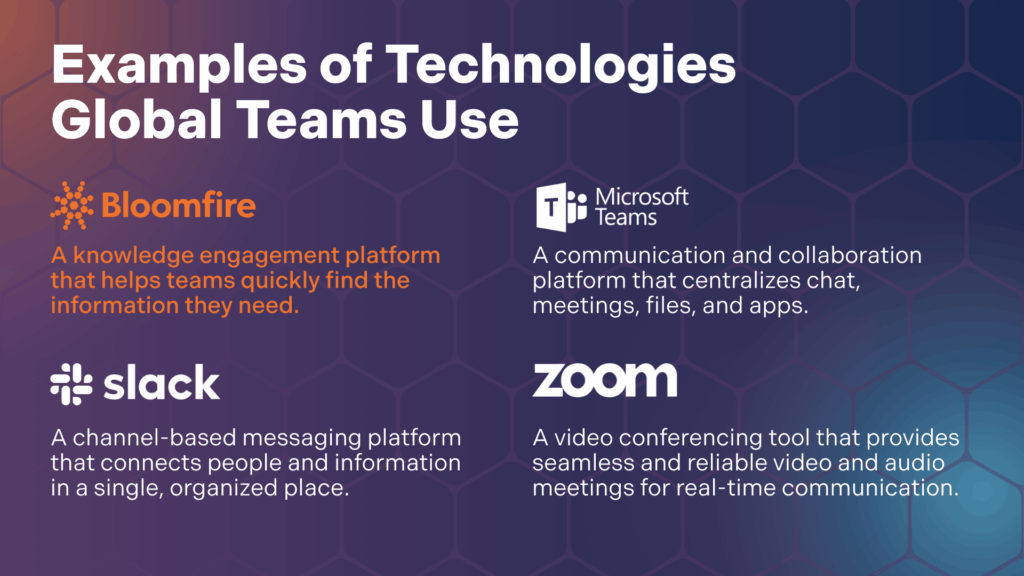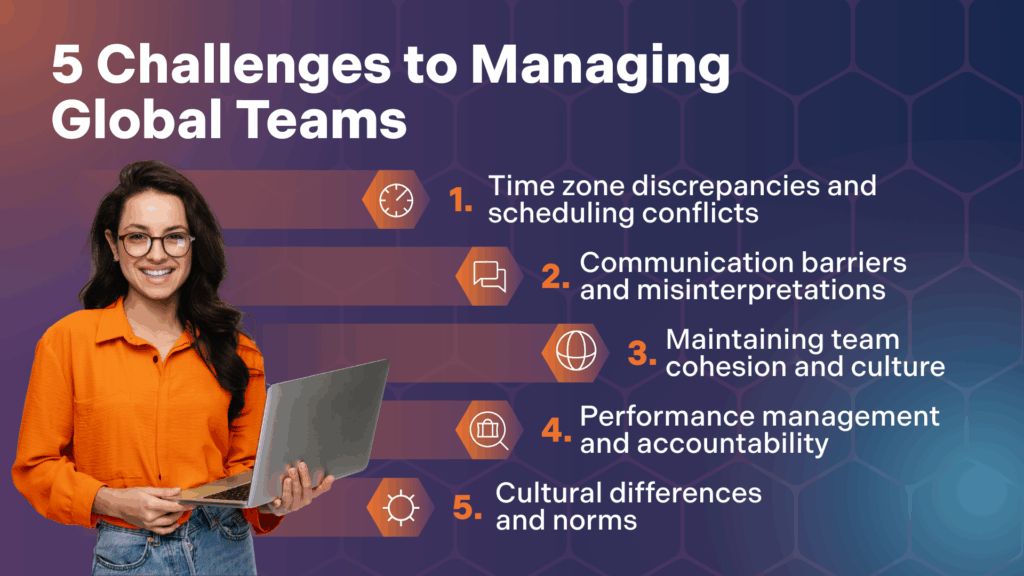How To Work Effectively With Global Teams: 7 Ways To Do It Right

Although global teams are not a new concept, businesses of all sizes are increasingly working with employees across time zones and borders. Post-pandemic, remote and hybrid work have become the norm, making it more feasible for many companies to hire talent in locations where they don’t have a physical office.
Working with global teams effectively requires a strategic approach that involves setting clear goals and expectations, fostering transparent communication and protocols, and providing a centralized knowledge base. It also includes leveraging technology for seamless collaboration, establishing a consistent schedule, building strong trust and relationships, and embracing cultural differences.
What Is a Global Team?
A global team is a group of individuals who collaborate from different geographical locations and time zones to achieve a common goal. Unlike traditional in-office teams or co-located teams, a global team is dispersed across various countries, bringing a diverse mix of cultural backgrounds, languages, and expertise.
Global teams are particularly common in multinational corporations, such as Google and Amazon, where employees from different regions collaborate on projects, leveraging their local market insights. The formation of these international teams has been dramatically influenced by the rise of virtual technology. The pandemic accelerated this trend, as companies were forced to adopt remote work on a massive scale.

Collaboration platforms and tools like Microsoft Teams, Slack, and Zoom have become the cornerstone of global teamwork, enabling real-time communication, project management, and virtual meetings. This technological infrastructure has enabled teams to overcome geographical barriers and has transformed the way they are managed.
A 2024 survey revealed that 16% of U.S. companies are now fully remote, with a significant portion of employees preferring remote or hybrid work arrangements. Additionally, a 2023 report found that 94% of professionals would like to continue working globally and remotely at least part-time for the remainder of their careers. This indicates a strong employee preference that drives the formation of global and virtual teams.
7 Ways to Work Effectively with Global Teams
Fostering a successful, collaborative environment for global teams that work takes time and effort–but it’s well worth it, especially when it leads to greater knowledge sharing across your organization. Here are seven tips on how to work effectively with global teams.

1. Set clear goals and expectations
Without a shared understanding of what needs to be accomplished and who is responsible for each task, teams can become fragmented and inefficient. No one should have to assume how they or their colleagues are spending their time or which items are a top priority. Clear goals act as a central compass, providing a unified sense of purpose and direction that transcends time zones and physical locations.
Setting clear goals and expectations provides a framework for accountability, collaboration, and trust. A Gallup survey reported that remote employees with clear goals are 3.6 times more likely to be engaged in their work. When every global team member knows their specific role and how their work contributes to the larger objective, they can work autonomously and efficiently without needing constant micromanagement.
2. Foster Clear Communication and Protocols
79% of employees believe that the quality of communication from their leaders directly impacts their understanding of organizational goals. When you set guidelines for transparent knowledge sharing, leaders can ensure every team member feels valued and informed.
Conduct regular check-ins, establish a defined process for feedback, and emphasize active listening. Companies that prioritize these practices see significant benefits, with research showing that effective communication processes can increase productivity by up to 25% and improve employee retention by 4.5 times.
3. Provide a Centralized Knowledge Base
One of the best things you can do to ensure your global team is efficient and effective is to provide everyone with access to all the resources they need to succeed. A centralized knowledge base serves as a single source of truth for all company information, breaking down information silos and ensuring consistency across different regions and time zones.
You can ensure all employees have access to the same knowledge, regardless of where they’re working. This way, team members can self-serve resources, so they don’t have to rely on colleagues being online at the same time when they have questions. A knowledge management solution like Bloomfire, which provides both an internal knowledge base and an Enterprise Intelligence engine, helps employees feel empowered and keeps projects moving forward.
4. Leverage Technology for Seamless Collaboration
Some team members will be working the same hours, while others may be ending their workday as their coworkers are just signing on. If team members do have an ad-hoc call or in-person conversation, encourage them to share details of that communication via collaboration platforms. This way, everyone is on the same page, even if they’re not in the same geographic location.
The strategic use of technology boosts productivity and innovation. For example, studies found that 64% of workers lose at least three hours a week due to poor collaboration.
Technologies such as knowledge management systems, like Bloomfire, project management platforms (e.g., Asana and Trello), communication apps (e.g., Slack and Microsoft Teams), and cloud-based document sharing (e.g., Google Workspace) are prime examples. These tools enable global teams to work together efficiently, share ideas, and make decisions quickly, ultimately leading to improved project outcomes and a more agile, responsive organization.
5. Establish a Schedule for Collaboration
A coordinated schedule identifies golden hours—overlapping work times when real-time collaboration can occur—while also promoting asynchronous virtual communication for tasks that don’t require immediate feedback. It provides a framework for when and how teams should connect, from daily check-ins on project management software to weekly video conferences. It also prevents team members from feeling pressured to work outside of their normal hours.
One-on-one meetings, in particular, are an essential component of this schedule, serving as a dedicated space for managers to connect with each team member individually. These meetings are not just for work updates; they also build rapport, address personal challenges, and provide opportunities for feedback and career development.
When it comes to crucial discussions, record your meetings so that team members can refer back to them. If you use Bloomfire, you can upload call or video recordings to the platform and automatically generate a searchable transcript, allowing team members to perform a keyword search and jump directly to the exact point in the meeting they’re looking for.
6. Build Trust and Relationships
Building strong relationships and fostering trust are fundamental to the success of managing a global team. When team members feel connected and valued, they are more likely to stay engaged and committed to their work. Leaders should make a deliberate effort to get to know each team member personally, understanding their interests, goals, and any challenges they face.
Creating a safe space for open communication allows leaders to encourage employees to share questions and concerns without fear of judgment. This also involves asking about topics important to the team and welcoming feedback to show their input is valued.
Beyond one-on-one connections, leaders should actively promote cross-cultural collaboration. They can build a virtual community where every voice is heard and conflict is addressed constructively. Practicing transparency and modeling positive behaviors further builds trust and encourages team members to do the same.

In the absence of face-to-face meetings, which are powerful for solidifying relationships, a strong virtual culture is essential. This means focusing on inclusive and welcoming practices, such as a comprehensive onboarding process that helps new hires feel integrated from day one. Regularly collecting feedback and publicly recognizing achievements—both from leaders and among peers—reinforces a culture of appreciation and mutual respect.
Virtual get-togethers and consistent team meetings also serve as crucial touchpoints that help people feel more comfortable reaching out to one another, regardless of geographical distance. These efforts collectively create a sense of belonging and support, which is the bedrock of a high-performing global team.
7. Embrace Cultural Differences
Ask your colleagues to inform you of their holiday schedule, hours they prefer to work, how they best communicate, and, of course, how the company can present itself in the most favorable light locally. Try to learn as much as you can about the local culture, and encourage your team to take an active role in training you in the best ways to work with them.
As you and your fellow leaders learn how to work with global teams, you’re bound to hit a few stumbling blocks. But, regardless of the setbacks, it’s important you put in the time and effort to support diversity and collaboration. By following these tips and implementing a knowledge management platform, you’ll be well on your way to developing a highly successful global team.
Challenges to Managing Geographically Distributed Teams
Geographically distributed teams present unique challenges that managers must address to maintain productivity, cohesion, and a healthy work environment. These challenges are often magnified by distance and a reliance on virtual communication.
For example, a disadvantage of global teams for product design is that they can struggle with maintaining a cohesive vision and consistent communication due to differences in time zones, cultural norms, and technical infrastructure. Fortunately, solutions for these issues are not difficult to come by.

Here are five specific challenges to managing international teams and some potential solutions:
1. Time zone discrepancies and scheduling conflicts
A team spread across different time zones—for instance, with members in New York, London, and Tokyo—faces a significant challenge in finding a common time for synchronous communication. Some team members may have to attend meetings at inconvenient hours, such as late at night or early in the morning, which can lead to fatigue, burnout, and a sense of being undervalued. It also makes real-time, spontaneous collaboration difficult.
Potential solutions:
- Establish core working hours that overlap for all team members. While this may still require some flexibility, it ensures that there is a dedicated window each day for real-time collaboration.
- Promote asynchronous collaboration by utilizing project management tools and collaboration platforms, allowing team members to provide updates and contribute to projects on their own time.
- Record meetings and making them available for those who couldn’t attend is also a crucial practice to keep everyone informed and included.
2. Communication barriers and misinterpretations
The absence of face-to-face interaction can lead to a breakdown in communication. In-person cues like body language, tone of voice, and facial expressions are often lost in text-based communication, which can lead to misinterpretations and misunderstandings.
A simple, direct email or chat message that may be neutral in intent could be perceived as rude or demanding without the context of a person’s expression. This can lead to a lack of trust, friction between team members, and a decline in overall team dynamics.
Potential solutions:
- Encourage a video-first culture for important conversations. While instant messaging is useful for quick updates, video calls are essential for team meetings, one-on-one check-ins, and collaborative discussions.
- Establish clear communication protocols—such as which tools to use for what kind of message (e.g., Slack for quick questions, email for formal announcements, and Zoom for discussions) and set expectations around response times.
- Model open and transparent communication, actively seeking clarification and encouraging team members to do the same.
3. Maintaining team cohesion and culture
Without a shared physical office space, it can be difficult to foster a sense of belonging and a strong company culture. Remote team members may feel isolated and disconnected from their colleagues and the organization as a whole.
The lack of informal interactions—like water cooler chats or spontaneous lunches—can hinder the development of rapport and personal relationships, which are essential for team bonding and psychological safety. This can lead to decreased motivation, higher employee turnover, and a lack of creative collaboration.
Potential solutions:
- Create intentional opportunities for social connection. This could include virtual coffee breaks, online team-building activities, or non-work-related chat channels.
- Celebrate team and individual successes publicly and providing regular recognition can also help reinforce a positive culture.
- Hold an annual or semi-annual in-person team retreat, if budget allows, can also be a powerful way to strengthen relationships and build camaraderie that will last throughout the year.
4. Performance management and accountability
Monitoring and evaluating the performance of a geographically distributed employee can be one of the common challenges of global teams, especially for managers accustomed to seeing their team members at their desks every day. The focus shifts from hours worked to outcomes produced, which can be a difficult transition.
It can be challenging for managers to identify when a team member is struggling or needs support, as they are not physically present to observe cues of stress or low productivity. This lack of visibility can also lead to a trust deficit where managers might subconsciously micromanage or, conversely, fail to provide adequate support.
Potential solutions:
- Shift from a time-based to a results-based management approach.
- Implement project management tools that offer a transparent overview of tasks and deadlines can also be helpful.
- Foster a culture of trust and autonomy, empowering team members to take ownership of their work while making it clear that support is always available when needed.
5. Cultural differences and norms
Communication styles, work ethics, attitudes towards authority, and expectations around feedback can vary dramatically between cultures. For example, a direct and assertive communication style that is common in some cultures might be perceived as aggressive in others. This can lead to misunderstandings, conflict, and a reluctance to collaborate effectively. It can also create a ‘us versus them’ mentality between different geographic subgroups.
Potential solutions:
- Cultivate cultural intelligence and promote a culture of respect and awareness. This can be achieved through training sessions on cross-cultural communication and by encouraging team members to share insights about their own cultures.
- Establish clear team norms and ground rules that everyone agrees on, and making these explicit from the start, is crucial. This can include guidelines on meeting etiquette, feedback delivery, and acceptable response times.
- Celebrate cultural diversity through virtual events or a shared calendar of global holidays can also help build a sense of unity and mutual respect.
Frequently Asked Questions
What are examples of management approaches for global teams?
Examples of management approaches for global teams include utilizing a centralized hub-and-spoke model for decision-making. Additionally, managers can adopt a matrix approach where employees report to both a local and a functional manager, or employ a fully virtual structure using technology to bridge geographical distances.
What is an example of a global team in the workplace?
A global team consists of employees working remotely across different countries and time zones, enabling a company to access a wide talent pool and operate around the clock. Companies such as Tata Consultancy Services and Cisco utilize this model, with teams distributed across multiple continents to serve their international clients and support follow-the-sun workflows.
How important is teamwork for international management?
Teamwork is crucial for international team management as it facilitates the effective collaboration of diverse individuals to achieve common organizational goals. A collaborative approach helps bridge cultural differences, fosters innovation, and ensures smooth communication across different regions.
Global Teams That Work
Global teams offer a wide range of potential benefits, including greater innovation and higher market share. But working with international teams also has plenty of challenges to navigate, from language barriers to cultural differences to time zone hurdles. Overcoming these obstacles requires a conscious effort to build a strong foundation of trust and respect. When team members feel safe and understood, they are far more likely to contribute their best work and collaborate effectively, no matter where they are located.
This blog post was most recently expanded and updated in August 2025 to reflect new information and best practices.
Equip Global Teams With a KM System
Make knowledge available to global teams anytime, anywhere.
Learn How Bloomfire Works

Enterprise AI Search: Definition, Benefits, and Evolution

The Benefit of Company-Wide Knowledge Management in 2026

Are You Making These Common Knowledge Sharing Mistakes?

Estimate the Value of Your Knowledge Assets
Use this calculator to see how enterprise intelligence can impact your bottom line. Choose areas of focus, and see tailored calculations that will give you a tangible ROI.

Take a self guided Tour
See Bloomfire in action across several potential configurations. Imagine the potential of your team when they stop searching and start finding critical knowledge.